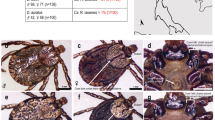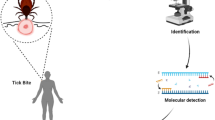Abstract
Argasid ticks are vectors of viral and bacterial agents of humans and animals. Recent reports indicate that some ornithophilic argasids harbored rickettsial agents. A Nearctic tick, Argas monolakensis Schwan, Corwin, Brown is ornithophilic and has not previously been examined for rickettsial agents. Thirty adult A. monolakensis were tested by PCR for DNA from Rickettsia or Coxiella. Amplicons from a Coxiella sp. that were divergent from Coxiella burnetii were detected in 16/30 A. monolakensis. These molecular isolates were similar but not identical to C. burnetii, the Coxiella spp. of other ticks, and “Coxiella cheraxi” a pathogen of crayfish.

Similar content being viewed by others
References
Carl M, Tibbs CW, Dobson ME, Paparello S, Dasch GA (1990) Diagnosis of acute typhus infection using the polymerase chain reaction. J Infect Dis 161:791–793
Denison AM, Thompson HA, Massung RF (2007) IS1111 insertion sequences of Coxiella burnetii: characterization and use for repetitive element PCR-based differentiation of Coxiella burnetii isolates. BMC Microbiol 7:91
El Shoura SM (1990) Ultrastructure and distribution of intracellular rickettsia-like microorganisms in various organs of the laboratory-reared adult tick Argas (Persicargas) arboreus (Ixodoidea: Argaside). Exp Appl Acarol 9:137–143
Hoogstraal H (1985) Argasid and nuttalliellid ticks as parasites and vectors. Adv Parasitol 24:135–238
Jasinskas A, Zhong J, Barbour AG (2007) Highly prevalent Coxiella sp. bacterium in the tick vector Amblyomma americanum. Appl Environ Microbiol 73:334–336
Lee JH, Park HS, Jang WJ, Koh SE, Park TK, Kang SS, Kim BJ, Kook YH, Park KH, Lee SH (2004). Identification of the Coxiella sp. detected from Haemaphysalis longicornis ticks in Korea. Microbiol Immunol 48:125–130
Loftis AD, Gill JS, Schriefer ME, Levin ML, Eremeeva ME, Gilchrist MJR, Dasch GA (2005) Detection of Rickettsia, Borrelia, and Bartonella in Carios kelleyi (Acari: Argasidae). J.Med Entomol 42:473–480
Loftis AD, Reeves WK, Szumlas DE, Abbassy MM, Helmy IM, Moriatiry JR, Dasch GA (2006) Rickettsial agents in Egyptian ticks collected from domestic animals. Exp Appl Acarol 40:67–81
Mediannikov O, Ivanov L, Nishikawa M, Saito R, Sidelnikov YN, Zdanovskaya NI, Tarasevich IV, Suzuki H (2003) Molecular evidence of Coxiella-like microorganism harbored by Haemaphysalis conicinnae in the Russian Far East. Ann NY Acad Sci 990:226–228
Reeves WK (2005) Molecular genetic evidence for a novel bacterial endosymbiont of Icosta americana (Diptera: Hippoboscidae). Entomol News 116:263–265
Reeves WK, Loftis AD, Sanders F, Spinks MD, Wills W, Denison AM, Dasch GA (2006a) Borrelia, Coxiella, and Rickettsia in Carios capensis (Acari: Argasidae) from a brown pelican (Pelecanus occidentalis) rookery in South Carolina, USA. Exp Appl Acarol 39:321–329
Reeves WK, Streicker DG, Loftis AD, Dasch GA (2006b) Serologic survey of Eptesicus fuscus from Georgia, USA for Rickettsia and Borrelia and laboratory transmission of a Rickettsia by bat ticks. J Vector Ecol 31:386–389
Roshdy MA (1968) A rickettsialike (sic) microorganism in the tick Ornithodoros savignyi; observations on its structure and distribution in the tissues of the tick. J Invert Path 11:155–169
Roux V, Rydkina E, Eremeeva M, Raoult D (1997) Citrate synthase gene comparison, a new tool for phylogenetic analysis, and its application for the rickettsiae. Int J Syst Bacteriol 47:252–61
Schwan TG, Oprandy JJ, Main AJ (1988) Mono Lake virus infecting Argas ticks (Acari: Argasidae) associated with California gulls breeding on islands in Mono Lake, California. J Med Entomol 25:381–387
Sekeyova Z, Roux V, Raoult D (1999) Intraspecies diversity of Coxiella burnetii as revealed by com1 and mucZ sequence comparison. FEMS Microbiol Lett 180:61–67
Skerman VBD, McGowan V, Sneath PHA (1980) Approved lists of bacterial names. Int J Syst Bacteriol 30:225–420
Willems H. Thiele D, Frolich-Ritter R, Krauss H (1994) Detection of Coxiella burnetii in cow’s milk using the polymerase chain reaction (PCR). J Vet Med Ser B 41:580–587
Zhong J, Jasinskas A, Barbour AG (2007) Antibiotic treatment of the tick vector Amblyomma americanum reduced reproductive fitness. PLoS ONE 2:e405
Acknowledgements
I thank T.G. Schwan for giving me access to freshly collected A. monolakensis and this project was partially funded by the American Society for Microbiology and the Centers for Disease Control and Prevention. The use of trade names in this document does not constitute an official endorsement or approval of the use of such commercial hardware or software. Do not cite this document for advertisement.
Author information
Authors and Affiliations
Corresponding author
Additional information
The U.S. Government’s right to retain a non-exclusive, royalty-free license in and to any copyright is acknowledged.
Rights and permissions
About this article
Cite this article
Reeves, W.K. Molecular evidence for a novel Coxiella from Argas monolakensis (Acari: Argasidae) from Mono Lake, California, USA. Exp Appl Acarol 44, 57–60 (2008). https://doi.org/10.1007/s10493-008-9128-z
Received:
Accepted:
Published:
Issue Date:
DOI: https://doi.org/10.1007/s10493-008-9128-z




